Jonah
Jonah יוֹנָה | |
|---|---|
 | |
| Prophet | |
| Born | 9th century BCE Gath-hepher, Kingdom of Israel |
| Died | 8th century BCE[1] |
| Venerated in | Judaism Christianity Islam Baháʼí Faith |
| Major shrine | Tomb of Jonah (destroyed), Mosul, Iraq |
| Father | Amittai |
| Feast | 21 September (Catholicism)[2] |
Jonah the son of Amittai or Jonas (Hebrew: יוֹנָה Yōnā, lit. 'dove')[a] is a Jewish prophet in the Hebrew Bible hailing from Gath-hepher in the Northern Kingdom of Israel around the 8th century BCE. He is the central figure of the Book of Jonah, one of the minor prophets, which details his reluctance in delivering the judgment of God to the city of Nineveh (near present-day Mosul) in the Neo-Assyrian Empire. After he is swallowed by a large sea creature (Hebrew: דג גדול, romanized: dāḡ gāḏol, lit. 'large fish') and then released, he returns to the divine mission.
In Judaism, the story of Jonah represents the teaching of repentance in Judaism, the ability to repent to God for forgiveness. In the New Testament of Christianity, Jesus calls himself "greater than Jonah" and promises the Pharisees "the sign of Jonah" when referring to his resurrection. Early Christian interpreters viewed Jonah as the type of Jesus. Jonah in Islam is regarded as a prophet and the narrative of Jonah appears in a surah of the Quran named after him, Yūnus.
Many modern Bible scholars suggest the Book of Jonah is fictional,[3][4][5][6] and at least partially satirical.[7][8] The character of Jonah son of Amittai may have been based on the historical prophet of the same name who prophesied during the reign of King Amaziah of Judah, as mentioned in 2 Kings.[9]
Although the creature that swallowed Jonah is often depicted in art and culture as a whale, the Hebrew text uses the phrase "large fish". In the 17th century and early 18th century, the species of the fish that swallowed Jonah was the subject of speculation by naturalists, who interpreted the story as an account of a historical incident. Some modern scholars of folklore, on the other hand, note similarities between Jonah and other legendary religious figures, like the Indian yogi Matsyendranatha "Lord of the Fishes", the Sumerian king Gilgamesh, and the Greek hero Jason.
Book of Jonah
[edit]
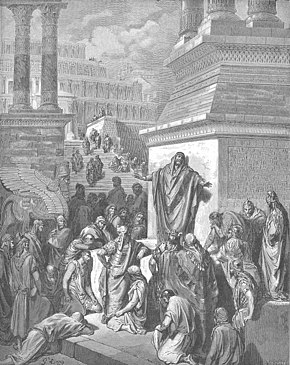
Jonah is the central character in the Book of Jonah, in which God commands him to go to the city of Nineveh to prophesy against it "for their great wickedness is come up before me,"[10] but Jonah instead attempts to flee from "the presence of the Lord" by going to Jaffa (sometimes transliterated as Joppa or Joppe). He sets sail for Tarshish.[11] A huge storm arises and the sailors, realizing that it is no ordinary storm, cast lots and discover that Jonah is to blame.[12] Jonah admits this and says that if he is thrown overboard, the storm will cease.[13] The sailors refuse to do this and continue rowing, but all their efforts fail, and they eventually throw Jonah overboard.[14] As a result, the storm calms and the sailors offer sacrifices to God.[15]
After being cast from the ship, Jonah is swallowed by a large fish, within the belly of which he remains for three days and three nights.[16] While in the great fish, Jonah prays to God in his affliction and commits to giving thanks and to paying what he has vowed.[17] God commands the fish to vomit Jonah out.[18]
God again commands Jonah to travel to Nineveh and prophesy to its inhabitants.[19] This time he travels there and enters the city, crying, "In forty days Nineveh shall be overthrown."[20] After Jonah has walked across Nineveh, the people begin to believe his word and proclaim a fast.[21] The king of Nineveh puts on sackcloth and sits in ashes, making a proclamation which decrees fasting, the wearing of sackcloth, prayer and repentance.[22] God sees their repentant hearts and spares the city at that time.[23] The entire city is humbled and broken, with the people (and even the livestock)[24][25] wearing sackcloth and ashes.[26]
Displeased by this, Jonah refers to his earlier flight to Tarshish while asserting that, since God is merciful, it was inevitable that God would turn from the threatened calamities.[27] He leaves the city and makes a shelter, waiting to see whether or not the city will be destroyed.[28] God causes a plant (in Hebrew a kikayon) to grow over Jonah's shelter to give him some shade from the sun.[29] Later, God causes a worm to bite the plant's root and it withers.[30] Jonah, exposed to the full force of the sun, becomes faint and pleads for God to kill him.[31]
But God said to Jonah: "Do you have a right to be angry about the vine?" And he said: "I do. I am angry enough to die."
But the LORD said: "You have been concerned about this vine, though you did not tend it or make it grow. It sprang up overnight, and died overnight.
But Nineveh has more than a hundred and twenty thousand people who cannot tell their right hand from their left, and many cattle as well. Should I not be concerned about that great city?"— Jonah 4:9–11 (NIV)
Religious views
[edit]In Judaism
[edit]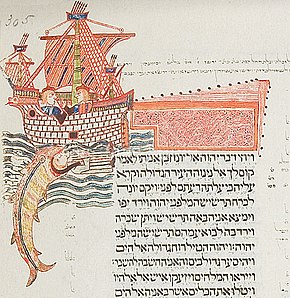
The Book of Jonah (Yonah יונה) is one of the twelve minor prophets included in the Hebrew Bible. According to one tradition, Jonah was the boy brought back to life by Elijah the prophet in 1 Kings.[32][33] Another tradition holds that he was the son of the woman of Shunem brought back to life by Elisha in 2 Kings[34][35] and that he is called the "son of Amittai" (Truth) due to his mother's recognition of Elijah's identity as a prophet in 1 Kings.[36][35] The Book of Jonah is read every year, in its original Hebrew and in its entirety, on Yom Kippur – the Day of Atonement – as the Haftarah at the afternoon mincha prayer.[37][38] According to Rabbi Eliezer, the fish that swallowed Jonah was created in the primordial era[39] and the inside of its mouth was like a synagogue;[39] the fish's eyes were like windows[39] and a pearl inside its mouth provided further illumination.[39]
According to the Midrash, while Jonah was inside the fish, the fish told him that its life was nearly over because soon the Leviathan would eat them both.[39] Jonah promised the fish that he would save them.[39] Following Jonah's directions, the fish swam up alongside the Leviathan[39] and Jonah threatened to leash the Leviathan by its tongue and let the other fish eat it.[39] The Leviathan heard Jonah's threats, saw that he was circumcised, and realized that he was protected by the Lord,[39] so it fled in terror, leaving Jonah and the fish alive.[39]
The medieval Jewish scholar and rabbi Abraham ibn Ezra (1092–1167) argued against any literal interpretation of the Book of Jonah,[40] stating that the "experiences of all the prophets except Moses were visions, not actualities."[40] The later scholar Isaac Abarbanel (1437–1509), however, argued that Jonah could have easily survived in the belly of the fish for three days,[41] because "after all, fetuses live nine months without access to fresh air."[42]
Teshuva – the ability to repent and be forgiven by God – is a prominent idea in Jewish thought. This concept is developed in the Book of Jonah: Jonah, the son of truth (the name of his father "Amitai" in Hebrew means truth), refuses to ask the people of Nineveh to repent. He seeks the truth only, and not forgiveness. When forced to go, his call is heard loud and clear, and the people of Nineveh repent ecstatically, "fasting, including the sheep," and the Jewish text is critical of this.[43] The Book of Jonah also highlights the sometimes unstable relationship between two religious needs: comfort and truth.[44]
Twelfth-century Jewish rabbi and explorer Petachiah of Regensburg visited Jonah's tomb during his visit to the Holy Land, and wrote: "There is a beautiful palace built over it. Near it is a pleasure garden wherein all kinds of fruit are found. The keeper of the pleasure garden is a Gentile. Nevertheless, when Gentiles come there he gives them no fruit, but when Jews come he gives them a friendly reception, saying, Jonah, son of Amittai, was a Jew, therefore it is due to you to partake of what is his, and then gives to the Jews to eat thereof." Petachiah did not provide details about the exact location of the tomb.[45]
In the Book of Tobit
Jonah is mentioned twice in the fourteenth chapter of the deuterocanonical Book of Tobit,[46] the conclusion of which finds Tobit's son, Tobias, rejoicing at the news of Nineveh's destruction by Nebuchadnezzar and Ahasuerus in apparent fulfillment of Jonah's prophecy against the Assyrian capital.[46]
In Christianity
[edit]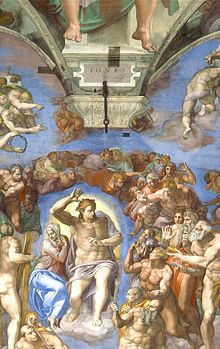
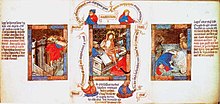
In the New Testament
[edit]In the New Testament, Jonah is mentioned in the gospels of Matthew[47] and Luke.[48][49] In Matthew, Jesus makes a reference to Jonah when he is asked for a sign by some of the scribes and the Pharisees.[50][51] Jesus says that the sign will be the sign of Jonah:[50][51] Jonah's restoration after three days and three night inside the great fish prefigures his own resurrection.[50]
39He answered, "A wicked and adulterous generation asks for a sign! But none will be given it except the sign of the prophet Jonah. 40For as Jonah was three days and three nights in the belly of a huge fish, so the Son of Man will be three days and three nights in the heart of the earth. 41The men of Nineveh will stand up at the judgment with this generation and condemn it; for they repented at the preaching of Jonah, and now something greater than Jonah is here."
— Gospel of Matthew, 12:39–41[52] (New International Version)
In Luke, Jesus makes a reference to Jonah in an eschatological prophecy, after a woman in the crowd suddenly exclaims, "Blessed is the womb that bare thee, and the paps which thou hast sucked" (Luke 11:27 - King James Version):
29And when the people were gathered thick together, he began to say, "This is an evil generation: they seek a sign; and there shall no sign be given it, but the sign of Jonas the prophet. 30For as Jonas was a sign unto the Ninevites, so shall also the Son of man be to this generation. 31The queen of the south shall rise up in the judgment with the men of this generation, and condemn them: for she came from the utmost parts of the earth to hear the wisdom of Solomon; and, behold, a greater than Solomon is here. 32The men of Nineve shall rise up in the judgment with this generation, and shall condemn it: for they repented at the preaching of Jonas; and, behold, a greater than Jonas is here. 33No man, when he hath lighted a candle, putteth it in a secret place, neither under a bushel, but on a candlestick, that they which come in may see the light. 34The light of the body is the eye: therefore when thine eye is single, thy whole body also is full of light; but when thine eye is evil, thy body also is full of darkness. 35Take heed therefore that the light which is in thee be not darkness. 36If thy whole body therefore be full of light, having no part dark, the whole shall be full of light, as when the bright shining of a candle doth give thee light."
— Gospel of Luke, 11:29–36[53] (King James Version)
Jonah is regarded as a saint by a number of Christian denominations. His feast day in the Roman Catholic Church is on 21 September, according to the Martyrologium Romanum.[2] On the Eastern Orthodox liturgical calendar, Jonah's feast day is on 22 September (for those churches which follow the traditional Julian calendar; 22 September currently falls in October on the modern Gregorian calendar).[54] In the Armenian Apostolic Church, moveable feasts are held in commemoration of Jonah as a single prophet and as one of the Twelve Minor Prophets.[55][56][57] Jonah's mission to the Ninevites is commemorated by the Fast of Nineveh in Syriac and Oriental Orthodox Churches.[58] Jonah is commemorated as a prophet in the Calendar of Saints of the Missouri Synod of the Lutheran Church on 22 September.[59]
Christian theologians have traditionally interpreted Jonah as a type for Jesus Christ.[60] Jonah being in swallowed by the giant fish was regarded as a foreshadowing of Jesus's crucifixion[61] and Jonah emerging from the fish after three days was seen as a parallel for Jesus emerging from the tomb after three days.[61] Saint Jerome equates Jonah with Jesus's more nationalistic side,[62] and justifies Jonah's actions by arguing that "Jonah acts thus as a patriot, not so much that he hates the Ninevites, as that he does not want to destroy his own people."[62]
Post-Biblical views
[edit]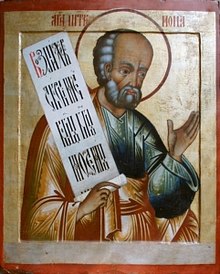
Other Christian interpreters, including Saint Augustine and Martin Luther, have taken a directly opposite approach,[63] regarding Jonah as the epitome of envy and jealousness, which they regarded as inherent characteristics of the Jewish people.[64] Luther likewise concludes that the kikayon (plant) represents Judaism,[65] and that the worm which devours it represents Christ.[66] Luther also questioned the idea that the Book of Jonah was ever intended as literal history,[67] commenting that he found it hard to believe that anyone would have interpreted it as such if it were not in the Bible.[67] Luther's antisemitic interpretation of Jonah remained the prevailing interpretation among German Protestants throughout early modern history.[68] J. D. Michaelis comments that "the meaning of the fable hits you right between the eyes",[64] and concludes that the Book of Jonah is a polemic against "the Israelite people's hate and envy towards all the other nations of the earth."[64] Albert Eichhorn was a strong supporter of Michaelis's interpretation.[69]
John Calvin and John Hooper regarded the Book of Jonah as a warning to all those who might attempt to flee from the wrath of God.[70] While Luther had been careful to maintain that the Book of Jonah was not written by Jonah,[71] Calvin declared that the Book of Jonah was Jonah's personal confession of guilt.[71] Calvin sees Jonah's time inside the fish's belly as equivalent to the fires of Hell, intended to correct Jonah and set him on the path of righteousness.[72] Also, unlike Luther, Calvin finds fault with all the characters in the story,[71] describing the sailors on the boat as "hard and iron-hearted, like Cyclops'",[71] the penitence of the Ninevites as "untrained",[71] and the king of Nineveh as a "novice".[71] Hooper, on the other hand, sees Jonah as the archetypal dissident[73] and the ship he is cast out from as a symbol of the state.[73] Hooper deplores such dissidents,[73] decrying: "Can you live quietly with so many Jonasses? Nay then, throw them into the sea!"[74] In the eighteenth century, German professors were forbidden from teaching that the Book of Jonah was anything other than a literal, historical account.[67]
In Islam
[edit]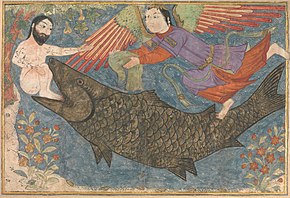
Part of a series on Islam Islamic prophets |
|---|
|
|
Quran
[edit]Jonah (Arabic: يُونُس, romanized: Yūnus) is the title of the tenth chapter of the Quran. Yūnus is traditionally viewed as highly important in Islam as a prophet who was faithful to God and delivered His messages. Jonah is the only one of Judaism's Twelve Minor Prophets to be named in the Quran.[75] In Quran 21:87[76] and 68:48, Jonah is called Dhul-Nūn (Arabic: ذُو ٱلنُّوْن; meaning "The One of the Fish").[77] In 4:163 and 6:86, he is referred to as "an apostle of Allah".[77] Surah 37:139–148 retells the full story of Jonah:[77]
And verily, Jonah was among the messengers.
[Mention] when he ran away to the laden ship.
Then (to save it from sinking) he drew straws (with other passengers). He lost and was thrown overboard.
Then the whale engulfed him while he was blameworthy.
Had it not been that he (repented and) glorified Allah,
He would certainly have remained inside the Fish till the Day of Resurrection.
But We cast him onto the open (shore), (totally) worn out,
and caused a squash plant to grow over him.
We (later) sent him (back) to (his city of) at least one hundred thousand people,
And they believed, so We allowed them enjoyment for a while.
The Quran never mentions Jonah's father,[77] but Muslim tradition teaches that Jonah was from the tribe of Benjamin and that his father was Amittai.[75]
Hadiths
[edit]Jonah is also mentioned in a few incidents during the lifetime of Muhammad. Quraysh sent their servant, Addas, to serve him grapes for sustenance.[79] Muhammad asked Addas where he was from and the servant replied Nineveh. "The town of Jonah the just, son of Amittai!" Muhammad exclaimed. Addas was shocked because he knew that the pagan Arabs had no knowledge of the prophet Jonah.[79] He then asked how Muhammad knew of this man. "We are brothers," Muhammad replied. "Jonah was a Prophet of God and I, too, am a Prophet of God." Addas immediately accepted Islam and kissed the hands and feet of Muhammad.[79]
One of the sayings attributed to Muhammad, in the collection of Imam Bukhari, says that Muhammad said "One should not say that I am better than Jonah".[80][81][82][83] Umayya ibn Abi al-Salt, an older contemporary of Muhammad, taught that, had Jonah not prayed to Allah, he would have remained trapped inside the fish until Judgement Day,[83] but, because of his prayer, Jonah "stayed only a few days within the belly of the fish".[83]
The ninth-century Persian historian Al-Tabari records that, while Jonah was inside the fish, "none of his bones or members were injured".[83] Al-Tabari also writes that Allah made the body of the fish transparent, allowing Jonah to see the "wonders of the deep"[84] and that Jonah heard all the fish singing praises to Allah.[84] Kisai Marvazi, a tenth-century poet, records that Jonah's father was seventy years old when Jonah was born[83] and that he died soon afterwards,[83] leaving Jonah's mother with nothing but a wooden spoon, which turned out to be a cornucopia.[83]
Claimed tombs
[edit]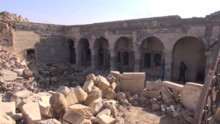
Nineveh's current location is marked by excavations of five gates, parts of walls on four sides, and two large mounds: the hill of Kuyunjik and hill of Nabi Yunus.[85] A mosque atop Nabi Yunus was dedicated to the prophet Jonah and contained a shrine, which was revered by both Muslims and Christians as the site of Jonah's tomb.[86] The tomb was a popular pilgrimage site[87] and a symbol of unity to Jews, Christians, and Muslims across the Middle East.[87] On July 24, 2014, the Islamic State of Iraq and the Levant (ISIL) destroyed the mosque containing the tomb as part of a campaign to destroy religious sanctuaries it deemed to be idolatrous.[88][87] After Mosul was taken back from ISIL in January 2017, an ancient Assyrian palace built by Esarhaddon dating to around the first half of the 7th century BCE was discovered beneath the ruined mosque.[87][89] ISIL had plundered the palace of items to sell on the black market,[87][89] but some of the artifacts that were more difficult to transport still remained in place.[87][89]
Other reputed locations of Jonah's tomb include:
- the Arab village of Mashhad, located on the ancient site of Gath-hepher in Israel;[49]
- the Nabi Yunis mosque of the Palestinian town of Halhul, in the West Bank, 5 km (3.1 mi) north of Hebron, was purportedly built over Jonah's tomb;[90][91]
- a sanctuary near the city of Sarafand (Sarepta) in Lebanon;[92]
- a hill now called Giv'at Yonah, "Jonah's Hill", at the northern edge of the Israeli town of Ashdod, at a site covered by a modern lighthouse;
- a "tomb of Jonah" in the city of Diyarbakir, Turkey, located behind the mihrab at Fatih Pasha Mosque[93][94] – Evliya Çelebi states in his Seyahatname that he visited the tombs of prophet Jonah and prophet George in the city.[95][96]
Scholarly interpretations
[edit]The story of a man surviving after being swallowed by a whale or giant fish is classified in the catalogue of folktale types as ATU 1889G.[97]
Historicity
[edit]Many Biblical scholars hold that the contents of the Book of Jonah are ahistorical.[4][98][99] Although the prophet Jonah allegedly lived in the eighth century BCE,[1] the Book of Jonah was written centuries later during the time of the Achaemenid Empire.[1][100] The Hebrew used in the Book of Jonah shows strong influences from Aramaic[1] and the cultural practices described in it match those of the Achaemenid Persians.[1][25] Some scholars regard the Book of Jonah as an intentional work of parody or satire.[7][8][101][102][103][104] If this is the case, then it was probably admitted into the canon of the Hebrew Bible by sages who misunderstood its satirical nature[105][103][104] and mistakenly interpreted it as a serious prophetic work.[105][103][104]
Jonah himself may have been a historical prophet;[106] he is briefly mentioned in the Second Book of Kings:[107][4]
He restored the border of Israel from the entrance of Hamath unto the sea of the Arabah, according to the word of the LORD, the God of Israel, which He spoke by the hand of His servant Jonah the son of Amittai, the prophet, who was of Gath-hepher.
— 2 Kings[108]
In a lecture delivered in 1978 and published in 1979, Assyriologist Donald Wiseman defended the plausibility of many aspects of the story, supporting "the tradition that many features in the narrative exhibit an intimate and accurate knowledge of Assyria which could stem from an historical event as early as the eighth century B.C.", concluding that "the story of Jonah need not be considered as a late story or parable".[109]
Parodic elements
[edit]
The views expressed by Jonah in the Book of Jonah are a parody of views held by members of Jewish society at the time when it was written.[8][111][102] The primary target of the satire may have been a faction whom Morton Smith calls "Separationists",[112] who believed that God would destroy those who disobeyed him,[102] that sinful cities would be obliterated,[102] and that God's mercy did not extend to those outside the Abrahamic covenant.[112] McKenzie and Graham remark that "Jonah is in some ways the most 'orthodox' of Israelite theologians – to make a theological point."[102] Jonah's statements throughout the book are characterized by their militancy,[102][113] but his name ironically means "dove",[102][113] a bird which the ancient Israelites associated with peace.[102]
Jonah's rejection of God's commands is a parody of the obedience of the prophets described in other Old Testament writings.[114] The king of Nineveh's instant repentance parodies the rulers throughout the other writings of the Old Testament who disregard prophetic warnings, such as Ahab and Zedekiah.[104] The readiness to worship God displayed by the sailors on the ship and the people of Nineveh contrasts ironically with Jonah's own reluctance,[115] as does Jonah's greater love for kikayon providing him shade than for all the people in Nineveh.[115]
The Book of Jonah also employs elements of literary absurdism;[25] it exaggerates the size of the city of Nineveh to an implausible degree[1][25] and incorrectly refers to the administrator of the city as a "king".[1][25] According to scholars, no human could realistically survive for three days inside a fish,[1] and the description of the livestock in Nineveh fasting alongside their owners is "silly".[25] Some of these points are countered in the aforementioned lecture of Donald Wiseman.[109]
The motif of a protagonist being swallowed by a giant fish or whale became a stock trope of later satirical writings.[116] Similar incidents are recounted in Lucian of Samosata's A True Story, which was written in the second century CE,[117] and in the novel Baron Munchausen's Narrative of his Marvellous Travels and Campaigns in Russia, published by Rudolf Erich Raspe in 1785.[118]
The fish
[edit]Translation
[edit]
Though art and culture often depicts Jonah's fish as a whale, the Hebrew text, as throughout scripture,[citation needed] refers to no marine species in particular, simply saying "great fish" or "big fish". While some biblical scholars suggest the size and habits of the great white shark correspond better to the representations of Jonah's experiences, normally an adult human is too large to be swallowed whole. The development of whaling from the 18th century onwards made it clear that most, if not all, species of whale are incapable of swallowing a human, leading to much controversy about the veracity of the biblical story of Jonah.[119]
In Jonah 2:1 (1:17 in English translations), the Hebrew text reads dag gadol[120] (דג גדול) or, in the Hebrew Masoretic Text, dāḡ gāḏōl (דָּ֣ג גָּד֔וֹל), which means "great fish".[120][121] The Septuagint translates this phrase into Greek as kētei megalōi (κήτει μεγάλῳ), meaning "huge fish".[122] In Greek mythology, the same word meaning "fish" (kêtos) is used to describe the sea monster slain by the hero Perseus that nearly devoured the Princess Andromeda.[123] Jerome later translated this phrase as piscis grandis in his Latin Vulgate.[124] He translated koilia kétous, however, as ventre ceti in Matthew 12:40:[125] this second case occurs only in this verse of the New Testament.[126][127]
At some point cetus became synonymous with "whale" (the study of whales is now called cetology). In his 1534 translation, William Tyndale translated the phrase in Jonah 2:1 as "greate fyshe" and the word kétos (Greek) or cetus (Latin) in Matthew 12:40[128] as "whale". Tyndale's translation was later incorporated into the Authorized Version of 1611. Since then, the "great fish" in Jonah 2 has been most often interpreted as a whale. In English some translations use the word "whale" for Matthew 12:40, while others use "sea creature" or "big fish".[129]
Scientific speculation
[edit]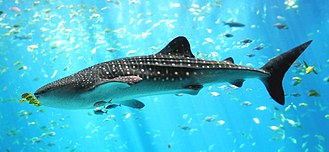
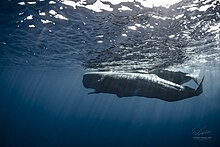
In the seventeenth and eighteenth centuries, naturalists, interpreting the Jonah story as a historical account, became obsessed with trying to identify the exact species of the fish that swallowed Jonah.[131] In the mid-nineteenth century, Edward Bouverie Pusey, professor of Hebrew at Oxford University, claimed that the Book of Jonah must have been authored by Jonah himself[132] and argued that the fish story must be historically true, or else it would not have been included in the Bible.[132] Pusey attempted to scientifically catalogue the fish,[133] hoping to "shame those who speak of the miracle of Jonah's preservation in the fish as a thing less credible than any of God's other miraculous doings".[134]
The debate over the fish in the Book of Jonah played a major role during Clarence Darrow's cross-examination of William Jennings Bryan at the Scopes trial in 1925.[135][136][67] Darrow asked Bryan "When you read that ... the whale swallowed Jonah ... how do you literally interpret that?"[135] Bryan replied that he believed in "a God who can make a whale and can make a man and make both of them do what He pleases."[135][67] Bryan ultimately admitted that it was necessary to interpret the Bible,[135] and is generally regarded as having come off looking like a "buffoon".[136]
The largest of all whales – blue whales – are baleen whales which eat plankton; and "it is commonly said that this species would be choked if it attempted to swallow a herring."[137] The largest of all fishes – the whale shark — has a large mouth, but its throat is only four inches wide, with a sharp elbow or bend behind the opening, such that not even a human arm would be able to pass through it. Therefore, Jonah could not have been swallowed by a whale shark.[138]
Sperm whales, however, appear to be a different matter: They regularly eat giant squid, so presumably one could swallow a human.[139] Similar to a cow, sperm whales have four-chambered stomachs.[139] The first chamber has no gastric juices but has muscular walls to crush its food.[140][141] On the other hand, it is not possible to breathe inside the sperm whale's stomach because there is no air (but probably methane instead).[139] A 2023 novel by Daniel Kraus explores the idea of a man surviving being swallowed by a sperm whale, but with an oxygen tank.[142]
Cultural influence
[edit]
In Turkish, "Jonah's fish" (yunus balığı) is the term used for dolphins.[143] A long-established expression among sailors uses the term "a Jonah" to mean a sailor/passenger whose presence on board brings bad luck and endangers the ship.[144] Later, this meaning was extended to "a person who carries a jinx, one who will bring bad luck to any enterprise."[145]
Despite its brevity, the Book of Jonah has been adapted numerous times in literature and in popular culture.[146][147] In Herman Melville's Moby-Dick (1851), Father Mapple delivers a sermon on the Book of Jonah. Mapple asks why Jonah does not show remorse for disobeying God while he is inside of the fish. He concludes that Jonah admirably understands that "his dreadful punishment is just."[148] Carlo Collodi's The Adventures of Pinocchio (1883) features the title character and his father Geppetto being swallowed by "the Terrible Dogfish," an allusion to the story of Jonah.[149] Walt Disney's 1940 film adaptation of the novel retains this allusion.[150] The story of Jonah was adapted into Phil Vischer and Mike Nawrocki's animated film Jonah: A VeggieTales Movie (2002). In the film, Jonah (portrayed by Archibald Asparagus) is swallowed by a gargantuan whale.[151]
Suggested connections to legends
[edit]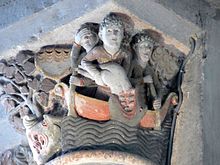
Epic of Gilgamesh
[edit]Joseph Campbell suggests that the story of Jonah parallels a scene from the Epic of Gilgamesh, in which Gilgamesh obtains a plant from the bottom of the sea.[152] In the Book of Jonah, a worm (in Hebrew tola'ath, "maggot") bites the shade-giving plant's root causing it to wither;[152] whereas in the Epic of Gilgamesh, Gilgamesh ties stones to his feet and plucks his plant from the floor of the sea.[152][153] Once he returns to the shore, the rejuvenating plant is eaten by a serpent.[152][154]
Jason (Greek mythology)
[edit]Campbell also noted several similarities between the story of Jonah and that of Jason in Greek mythology.[152] The Greek rendering of the name Jonah is Jonas (Ἰωνᾶς), which differs from Jason (Ἰάσων) only in the order of sounds—both os are omegas suggesting that Jason may have been confused with Jonah.[152] Gildas Hamel, drawing on the Book of Jonah and Greco-Roman sources—including Greek vases and the accounts of Apollonius of Rhodes, Gaius Valerius Flaccus and Orphic Argonautica—identifies a number of shared motifs, including the names of the heroes, the presence of a dove, the idea of "fleeing" like the wind and causing a storm, the attitude of the sailors, the presence of a sea-monster or dragon threatening the hero or swallowing him, and the form and the word used for the "gourd" (kikayon). Hamel takes the view that it was the Hebrew author who reacted to and adapted this mythological material to communicate his own quite different message.[155]
See also
[edit]- Aquanaut, a person who stays underwater for a long time
- Biblical and Quranic narratives
- Jonah on the Sistine Chapel ceiling
- Legends and the Quran
- Prophets of Islam
- Qisas Al-Anbiya
Further reading
[edit]- Driscoll, James F. (1910). . In Herbermann, Charles (ed.). Catholic Encyclopedia. Vol. 8. New York: Robert Appleton Company.
- Friedrich Justus Knecht (1910). . A Practical Commentary on Holy Scripture. B. Herder.
- Lasine, Stuart. 2020. Jonah and the Human Condition: Life and Death in Yahweh’s World.New York: Bloomsbury/T & T Clark.
Notes
[edit]References
[edit]- ^ a b c d e f g h i Levine 2000, p. 71.
- ^ a b The Roman Martyrology. Westminster, Maryland: Newman Bookshop. 1944. p. 327.
- ^ Tawfeeq, Dana Ford,Mohammed (24 July 2014). "Extremists destroy Jonah's tomb, officials say". CNN. Retrieved 3 March 2024.
Biblical scholars are divided on whether the tomb in Mosul actually belonged to Jonah. In the Jewish tradition, he returns to his hometown of Gath-Hepher after his mission to Nineveh. And some modern scholars say the Jonah story is more myth than history.
{{cite web}}: CS1 maint: multiple names: authors list (link) - ^ a b c Kripke 1980, p. 67.
- ^ Jenson 2009, p. 30.
- ^ Chisholm 2009, p. unpaginated: "Despite the modern scholarly consensus that the book is fictional, [...]"
- ^ a b Band 2003, pp. 105–107.
- ^ a b c Ben Zvi 2003, pp. 18–19.
- ^ Hebrew-English Bible 2 Kings 14:25
- ^ Jonah 1:2
- ^ Jonah 1:3
- ^ Jonah 1:4–7
- ^ Jonah 1:8–12
- ^ Jonah 1:13–15
- ^ Jonah 1:15–16
- ^ Jonah 1:17
- ^ Jonah 2:1–9
- ^ Jonah 2:10
- ^ Jonah 3:1–2
- ^ Jonah 3:2–4
- ^ Jonah 3:5
- ^ Jonah 3:6–9
- ^ Jonah 3:10
- ^ Jonah 3:8
- ^ a b c d e f g Gaines 2003, p. 25.
- ^ Jonah 3:
- ^ Jonah 4:1–4
- ^ Jonah 4:5
- ^ Jonah 4:6
- ^ Jonah 4:7
- ^ Jonah 4:8
- ^ 1 Kings 17
- ^ Green 2005, pp. 126–127.
- ^ 2 Kings 4
- ^ a b Green 2005, p. 127.
- ^ 1 Kings 17:24
- ^ Mirsky 1990, p. 354.
- ^ Isaacs 2006, p. 65.
- ^ a b c d e f g h i j Green 2005, p. 128.
- ^ a b Gaines 2003, p. 20.
- ^ Gaines 2003, p. 18.
- ^ Gaines 2003, pp. 18–19.
- ^ "Sanhedrin". Babylonian Talmud. 61a..
- ^ Bashevkin, Dovid. "Jonah and the Varieties of Religious Motivation." Archived 12 October 2016 at the Wayback Machine Lehrhaus. 9 October 2016. 11 October 2016.
- ^ Travels of Rabbi Petachia of Ratisbon, p. 59
- ^ a b Bredin 2006, pp. 47–50.
- ^ Matthew 12:38–41 and 16:4
- ^ Luke 11:29–32
- ^ a b Limburg 1993, p. 39.
- ^ a b c Stein 1994, p. 3.
- ^ a b Sanders 1993, p. 167.
- ^ Matthew 12:39–41
- ^ Luke 11:29–36
- ^ "Lives of all saints commemorated on September 22". Orthodox Church in America. 22 September 2017. Retrieved 13 March 2018.
- ^ "Commemoration of the Prophet Jonah". Diocese of the Armenian Apostolic Orthodox Holy Church in Georgia. Archived from the original on 14 March 2018. Retrieved 13 March 2018.
- ^ "Commemoration of the 12 Minor Prophets". Diocese of the Armenian Apostolic Orthodox Holy Church in Georgia. Archived from the original on 14 March 2018. Retrieved 13 March 2018.
- ^ "Commemoration Day of the 12 Minor Prophets. 24 July 2018". Saint Stepanos Armenian Apostolic Church of Elberon in New Jersey. Archived from the original on 14 March 2018. Retrieved 13 March 2018.
- ^ "Three day fast of Nineveh". Syriac Orthodox Resources. 8 February 1998. Retrieved 12 March 2018.
- ^ "The Commemoration of Jonah, Prophet, 22 September". Concordia and Koinonia. Retrieved 13 March 2018.
- ^ Sherwood 2000, pp. 11–20.
- ^ a b Sherwood 2000, pp. 11–13.
- ^ a b Sherwood 2000, p. 20.
- ^ Sherwood 2000, pp. 23–25.
- ^ a b c Sherwood 2000, p. 25.
- ^ Sherwood 2000, pp. 23–24.
- ^ Sherwood 2000, p. 24.
- ^ a b c d e Gaines 2003, p. 19.
- ^ Sherwood 2000, pp. 24–26.
- ^ Sherwood 2000, pp. 25–26.
- ^ Sherwood 2000, pp. 32–33.
- ^ a b c d e f Sherwood 2000, p. 33.
- ^ Sherwood 2000, pp. 34–36.
- ^ a b c Sherwood 2000, pp. 39–40.
- ^ Sherwood 2000, p. 40.
- ^ a b Encyclopedia of Islam, Yunus, pg. 348
- ^ Quran 21:87
- ^ a b c d Vicchio 2008, p. 67.
- ^ G’nsel Renda (1978). "The Miniatures of the Zubdat Al- Tawarikh". Turkish Treasures Culture /Art / Tourism Magazine. Archived from the original on 4 September 2016.
- ^ a b c Summarized from The Life of the Prophet by Ibn Hisham Volume 1 pp. 419–421
- ^ Sahih al-Bukhari 3395
- ^ Wheeler 2002, p. 172.
- ^ Graham 1977, p. 167.
- ^ a b c d e f g Vicchio 2008, p. 73.
- ^ a b Vicchio 2008, p. 74.
- ^ "Link to Google map with Nineveh markers at gates, wall sections, hills and mosque". Goo.gl. 19 March 2013. Retrieved 29 June 2014.
- ^ "ISIS destroys 'Jonah's tomb' in Mosul". Al Arabiya. 25 July 2014. Archived from the original on 27 July 2014. Retrieved 28 July 2014.
The radical Islamic State of Iraq and Syria (ISIS) group has destroyed shrines belonging to two prophets, highly revered by both Christians and Muslims, in the northern city of Mosul, al-Sumaria News reported Thursday. "ISIS militants have destroyed the Prophet Younis (Jonah) shrine east of Mosul city after they seized control of the mosque completely," a security source, who kept his identity anonymous, told the Iraq-based al-Sumaria News.
- ^ a b c d e f Samuel, Farhan & Lawandow 2017.
- ^ Ford & Tawfeeq 2014.
- ^ a b c Ensor 2017.
- ^ Friedman 2006, p. 64.
- ^ "Halhoul". www.travelpalestine.ps. Retrieved 8 January 2023.
- ^ Costa 2013, p. 97.
- ^ Talha Ugurluel, Dünyaya Hükmeden Sultan Kanuni: Gerçeklerin Anlatıldığı Bir Tarih Kitabı, Timas, 2013.
- ^ Hz. Yunus ve Diyabakir Archived 13 June 2021 at the Wayback Machine WowTurkey. Posted 16 August 2011.
- ^ EVLİYA ÇELEBİ’NİN SEYAHATNAME’SİNDE DİYARBAKIR (Turkish)
- ^ EVLİYA ÇELEBİ DİYARBAKIR’DA (Turkish) Archived 13 June 2021 at the Wayback Machine TigrisHaber. Posted 22 July 2014.
- ^ Ziolkowski 2007, p. 78.
- ^ Ingram 2012, p. 140.
- ^ Levine 2000, pp. 71–72.
- ^ Ben Zvi 2003, pp. 15–16.
- ^ Ingram 2012, pp. 140–142.
- ^ a b c d e f g h McKenzie & Graham 1998, p. 113.
- ^ a b c Person 1996, p. 155.
- ^ a b c d Gaines 2003, pp. 22–23.
- ^ a b Band 2003, pp. 106–107.
- ^ Kripke 1980, pp. 67–68.
- ^ Doyle 2005, p. 124.
- ^ 2 Kings 14:25, JPS (1917)
- ^ a b "Archaeology and the Book of Jonah", delivered in January, 1978, published as Donald Wiseman (1979). "Jonah's Nineveh" (PDF). Tyndale Bulletin. 30: 29–52. Archived from the original (PDF) on 12 January 2012.
- ^ Romey 2016.
- ^ Band 2003, p. 106.
- ^ a b Band 2003, p. 105.
- ^ a b Ingram 2012, p. 142.
- ^ Gaines 2003, p. 22.
- ^ a b Gaines 2003, p. 23.
- ^ Ziolkowski 2007, pp. 74–81.
- ^ Ziolkowski 2007, p. 76-77.
- ^ Ziolkowski 2007, pp. 77–78.
- ^ Kemp, Peter Kemp (1979). The Oxford Companion to Ships & the Sea. Oxford University Press. p. 434. ISBN 978-0-586-08308-6. Archived from the original on 17 February 2017.
- ^ a b "Yonah - Strong's Hebrew Lexicon (LXX)". Blue Letter Bible. Archived from the original on 11 September 2016. Retrieved 24 August 2016.
- ^ Interlinear Bible: Greek, Hebrew, Transliterated, English ... Bible Hub. Archived from the original on 11 September 2016. Retrieved 24 August 2016.
- ^ Robertson, A. T. (1960). Word Pictures in the New Testament – Matthew. Christian Classics Ethereal Library. p. 99. ISBN 978-1-610-25188-4. Archived from the original on 6 December 2016.
- ^ Bremmer 2014, p. 28.
- ^ Jonah 2:1
- ^ Matthew 12:40
- ^ Ziolkowski 2007, p. 81.
- ^ Parris, David Paul (2015). Reading the Bible with Giants. How 2000 Years of Biblical Interpretation Can Shed New Light on Old Texts (2 ed.). Eugene, Oregon: Wipf and Stock Publishers. p. 40. ISBN 978-1-625-64728-3.
What is interesting...is the way that Jerome...translated the references to the big fish in Jonah and Matthew. [...] In translating Matt 12:40, however, he follows the Greek text and says that Jonah was in the ventre ceti—the belly of the whale/sea monster"
- ^ Matthew 12:40
- ^ Huber, Walt; Huber, Rose (2013). How Did God Do It? A Symphony of Science and Scripture. Victoria, British Columbia: Friesen Press. p. 216. ISBN 978-1-460-21127-4.
The word whale is never used in the book of Jonah. The only biblical reference to "Jonah and the whale" appears in the New Testament in Matthew 12:40 (KJV & RSV). [...] Whale is not used in the other translations: TEV uses big fish; NLT, great fish; and TNIV, huge fish"
- ^ Wood, Gerald L. (1976). The Guinness Book of Animal Facts and Feats. Guinness Superlatives. ISBN 978-0-900424-60-1.
- ^ Sherwood 2000, pp. 42–45.
- ^ a b Green 2011, p. 48.
- ^ Sherwood 2000, pp. 47–48.
- ^ Sherwood 2000, p. 48.
- ^ a b c d Smolla, Rodney A. (5 October 1997). "Monkey Business". The New York Times. Retrieved 6 February 2024.
- ^ a b Lidz, Franz (April 2016). "How Much Has the Town Where the Scopes Trial Took Place Evolved Since the 1920s?". Smithsonian. Washington, D.C.: Smithsonian Institution.
- ^ Lydekker's New Natural History, Vol, III, p. 6.
- ^ Gudger, Eugene Willis (1940). "Twenty-five Years' Quest of the Whale Shark". The Scientific Monthly. 50 (3): 225–233. Bibcode:1940SciMo..50..225G. JSTOR 16929.
- ^ a b c Eveleth, Rose (25 February 2013). "Could a whale accidentally swallow you? It is possible". Smithsonian. Retrieved 21 March 2020.
- ^ Reidenberg, Joy (19 November 2014). "What would happen if you were swallowed by a whale?". The Naked Scientists. Retrieved 7 May 2021.
- ^ Smith, Chris; Scales, Helen (27 June 2010). "Could a human survive swallowing by a whale?". The Naked Scientists. Retrieved 7 May 2021.
- ^ Whalefall by Daniel Kraus.[1] See Neil McRobert (23 August 2023). "Whalefall review: Stunning novel about being swallowed by a whale". New Scientist.
- ^ Sevket Turet; Ali Bayram (1 May 1996). Practical English-Turkish handbook. Hippocrene Books. p. 361. ISBN 9780781804769. Archived from the original on 13 February 2018.
- ^ "Afflicted with a Jonah; The Sea Captain's Fear of Parsons' Sons" (PDF). The New York Times. 6 March 1885.
- ^ "Jonah". Collins English Dictionary (11 ed.). Archived from the original on 27 June 2012. Retrieved 6 October 2012.
- ^ Green 2005, p. xv.
- ^ Sherwood 2000, pp. 71–72.
- ^ Lewis, John (21 July 2017). "The Problem with Herman Melville's Reading of the Book of Jonah". Mosaic. Archived from the original on 13 February 2018. Retrieved 3 January 2018.
- ^ Marrone 2007, p. 486.
- ^ Pinsky 2004, p. 31.
- ^ Deming, Mark. "Jonah: A VeggieTales Movie (2002)". AllMovie. Archived from the original on 10 November 2017. Retrieved 9 November 2017.
- ^ a b c d e f Campbell 1988, pp. 90–95.
- ^ Dalley 1989, pp. 118–119.
- ^ Dalley 1989, p. 119.
- ^ Hamel, Gildas (25 April 2015) [1995]. "Taking the Argo to Nineveh: Jonah and Jason in a Mediterranean Context" (PDF). Judaism. 44 (3): 1–21.
Bibliography
[edit]- Band, Arnold J. (2003). Studies in Modern Jewish Literature. JPS Scholar of Distinction Series. Philadelphia, Pennsylvania: The Jewish Publication Society. ISBN 0-8276-0762-8.
- Ben Zvi, Ehud (2003). The Signs of Jonah: Reading and Rereading in Ancient Yehud. Sheffield, England: Sheffield Academic Press. ISBN 0-8264-6268-5.
- Bredin, Mark (2006). Studies in the Book of Tobit: A Multiple Disciplinary Approach. New York City, New York and London, England: T&T Clark. ISBN 0-567-08229-6.
- Bremmer, Jan M. (2014) [1987]. Interpretations of Greek Mythology. New York City, New York and London, England: Routledge. ISBN 978-1-315-81300-4.
- Campbell, Joseph (1988). The Hero With A Thousand Faces. Princeton, New Jersey: Princeton University Press. pp. 90–95. ISBN 0-586-08571-8.
- Chisholm, Robert B. Jr. (2009). Handbook on the Prophets. Baker Publishing Group. p. unpaginated. ISBN 978-1-58558-365-2.
- Costa, Nicholas (2013). Adam to Apophis: Asteroids, Millenarianism and Climate Change. Lemona, Cyprus: D'Aleman Publishing. ISBN 978-9963-2917-0-0.
- Dalley, Stephanie (1989). Myths from Mesopotamia: Creation, the Flood, Gilgamesh, and Others. Oxford, England: Oxford University Press. ISBN 0-19-283589-0.
- Doyle, Brian (2005). Martínez, F. García; Vervenne, M. (eds.). Interpreting Translation: Studies on the LXX and Ezekiel in Honour of Johan Lust. Leuven, Belgium: Leuven University Press. ISBN 90-429-1689-3.
- Dunlap, Janine W.; Warren, Hillary (2013). "VeggieTales". In Woods, Robert H. (ed.). Evangelical Christians and Popular Culture: Pop Goes the Gospel. Vol. 1, Film, Radio, and the Internet. Santa Barbara, California: Praeger: An Imprint of ABC Clio. ISBN 978-0313386541.
- Ensor, Josie (28 February 2017). "Previously Untouched 600 BC Palace Discovered Under Shrine Demolished by ISIL in Mosul". The Telegraph. Retrieved 6 February 2024.
- Samuel, Sigal; Farhan, Sara; Lawandow, Atoor (24 July 2017). "ISIS Destroyed Jonah's Tomb, but Not Its Message". The Atlantic. Retrieved 6 February 2024.
- Ford, Dana; Tawfeeq, Mohammed (25 July 2014). Extremists Destroy Jonah's Tomb, Officials Say. CNN.com.
- Friedman, Saul S. (2006). A History of the Middle East. Jefferson, North Carolina: MacFarland & Company, Inc., Publishers. ISBN 0-7864-2356-0.
- Gaines, Janet Howe (2003). Forgiveness in a Wounded World: Jonah's Dilemma. Atlanta, Georgia: Society of Biblical Literature. ISBN 1-58983-077-6.
- Graham, William Albert (1977). Divine Word and Prophetic Word in Early Islam: A Reconsideration of the Sources with Special Reference to the Ḥadîth Qudsî. The Hague, The Netherlands: Mouton & Co. ISBN 90-279-7612-0.
- Green, Barbara (2005) [2005]. Jonah's Journeys. Interfaces. Collegeville, Minnesota: Liturgical Press. ISBN 0-8146-5038-4.
- Green, Barbara (2011). "The Old Testament in Christian Spirituality". In Holder, Arthur (ed.). The Blackwell Companion to Christian Spirituality. Chichester, England: Wiley-Blackwell. ISBN 978-1-4501-0247-6.
- Ingram, Virginia (2012). "Satire and Cognitive Dissonance in the Book of Jonah, In the Light of Ellen's Laws of Psychological Hermeneutics". In Ellens, J. Harold (ed.). Psychological Hermeneutics for Biblical Themes and Texts: A Festschrift in Honor of Wayne G. Rollins. London: Bloomsbury Publishing. ISBN 978-0567566027.
- Isaacs, Ronald H. (2006). Questions Christians Ask the Rabbi. Brooklyn, New York: KTAV Publishing House. ISBN 0-88125-924-1.
- Jenson, Philip Peter (2009). Obadiah, Jonah, Micah: A Theological Commentary. The Library of Hebrew Bible/Old Testament Studies. Bloomsbury Publishing. p. 30. ISBN 978-0-567-44289-5.
- Kripke, Saul A. (1980) [1972]. Naming and Necessity. Cambridge, Massachusetts: Harvard University Press. ISBN 978-0674598461.
- Levine, Étan (2000). Heaven and Earth, Love and Law: Studies in Biblical Thought. Berlin: Walter de Gruyter. ISBN 3-11-016952-5.
- Limburg, James (1993). Jonah: A Commentary. Louisville, Kentucky: Westminster Knox Publishers. ISBN 0-664-21296-4.
- Marrone, Gaetana (2007). Encyclopedia of Italian Literary Studies: A-J. New York City, New York and London, England: Routledge. ISBN 978-1-57958-390-3.
- McKenzie, Stepehn L.; Graham, Matt Patrick (1998). The Hebrew Bible Today: An Introduction to Critical Issues. Louisville, Kentucky: Westminster Knox Press. ISBN 0-664-25652-X.
- Mirsky, Mark Jay (1990). Rabbinic Fantasies: Imaginative Narratives from Classical Hebrew Literature. New Haven, Connecticut: Yale University Press. ISBN 0-300-07402-6.
- Person, Raymond (1996). In Conversation with Jonah: Conversation Analysis, Literary Criticism, and the Book of Jonah. Sheffield, England: Sheffield Academic Press. ISBN 1-85075-619-8.
- Pinsky, Mark I. (2004). The Gospel According to Disney. Louisville, London: Westminster John Knox Press. ISBN 0-664-22591-8.
- Romey, Kristin (19 April 2016). "Exclusive Photos Show Destruction of Nineveh Gates by ISIS". National Geographic. The National Geographical Society. Archived from the original on 19 April 2016.
- Sanders, E. P. (1993). The Historical Figure of Jesus. London, England, New York City, New York, Ringwood, Australia, Toronto, Ontario, and Auckland, New Zealand: Penguin Books. ISBN 0-14-014499-4.
- Sherwood, Yvonne (2000). A Biblical Text and Its Afterlives: The Survival of Jonah in Western Culture. Cambridge, England: Cambridge University Press. ISBN 0-521-79561-3.
- Stein, Robert H. (1994). The Method and Message of Jesus' Teachings. Louisville, Kentucky: Westminster John Knox Press. ISBN 0-664-25513-2.
- Vicchio, Stephen J. (2008). Biblical Figures in the Islamic Faith. Eugene, Oregon: Wipf & Stock. ISBN 978-1-55635-304-8.
- Walton, John H.; Armerding, Carl E.; Walker, Larry L. (2017) [1985]. Jonah, Nahum, Habukkuk, Zephaniah. The Expositor's Bible Commentary. Grand Rapids, Michigan: Zondervan. ISBN 978-0-310-53196-8.
- Wheeler, Brannon M. (2002). Prophets in the Quran: An Introduction to the Quran and Muslim Exegesis. New York City, New York and London, England. ISBN 0-8264-4957-3.
{{cite book}}: CS1 maint: location missing publisher (link) - Ziolkowski, Jan M. (2007). Fairy Tales from Before Fairy Tales: The Medieval Latin Past of Wonderful Lies. Ann Arbor, Michigan: University of Michigan Press. ISBN 978-0-472-03379-9.
External links
[edit]- Jonah leaving whale
- The Book of Jonah (Hebrew and English)
- The Book of Jonah (NIV)
- Hirsch, Emil G.; Budde, Karl (1906). "Jonah, Book of". In Singer, Isidore; et al. (eds.). The Jewish Encyclopedia. New York: Funk & Wagnalls.
- Prophet Jonah Orthodox icon and synaxarion
- The Prophet Jonah at the Christian Iconography website

